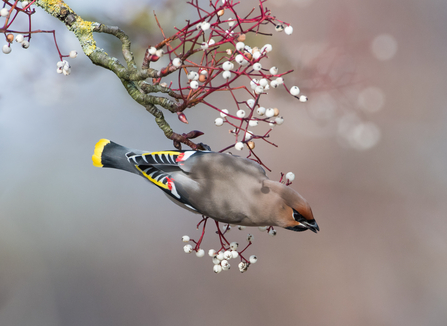
Waxwing by Don Sutherland
Yew trees are frequently found in churchyards and at this time of year can be identified by their bright red 'berries' – properly called arils

Waxwing by Don Sutherland
As autumn draws to a close, there’s one question at the top of the keen birdwatcher’s mind – will it be a ‘waxwing winter’?
The waxwing is one of the UK's most colourful winter visitors, and, with its striking orange-and-black head, white-striped wings and yellow tail tip, it looks almost tropical picking the berries off trees.
Whilst there are usually some present each winter, sometimes thousands of these birds flock to the UK during the season. After several sparse years, 2023 enjoyed an influx beginning in Scotland and northern England before spreading down to our three counties. Look out for large groups descending on anything with berries - such as rowan trees - in car parks and gardens. Who knows what this season will bring…
A peacock butterfly basking after hibernation (c) Richard Burkmar
While the most common way for butterflies to spend the cold months are as caterpillars, a few species buck the trend and overwinter as adults, sheltering from the worst of the weather in caves, tree cavities or even sheds and garages. These include the small tortoiseshell and peacock butterflies that occasionally try to hide away in houses. A chance encounter with one of these sheltering creatures is a welcome reminder that we’ll be treated to their colourful displays again in just a few months.
Discover the different ways moths and butterflies spend the winter
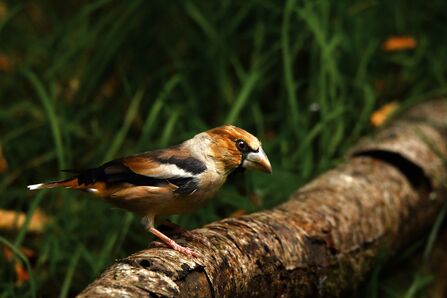
Hawfinches are the UK's largest finch and are easily identified, once you find one, by their very large bill
Hawfinches are the UK's largest finch and are easily identified, once you find one, by their very large bill, also by a repeated sharp metallic ‘pix’ call given from treetops. The number of hawfinches increases in winter as birds from colder parts of Europe arrive here to find food, so keep an eye out, particularly in open, mature woodlands.
Warburg Nature Reserve near Henley was home to a family of hawfinches over this summer, and is an enchanting place to visit at any time of year.
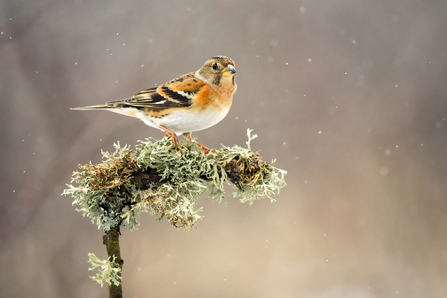
Brambling by WildlifeWorld for Shutterstock
Another avian winter visitor to the UK is the brambling. These petite songbirds are close relatives of the chaffinch and can often be found in the same flocks, where their white rumps and nasal calls give them away. They're often found in woodlands, hedgerows and stubble fields, and will sometimes visit garden bird feeders.

Photo: Ben Porter
The vibrant colours of autumn have passed into the skeletal forms of our winter trees, but don’t despair, as this provides fantastic wildlife-spotting opportunities! Not only are birds easier to see without the abundance of green cover, but the decaying leaves carpeting the floor are home to all sorts of invertebrates.
Gently push aside leaf litter and you will find beetles hunting for snails, tiny springtails that ping out of the way, larvae of moths and nymphs of bugs. You could even collect a bag of leaf litter and put it in a deep tray to sift through and discover the beasties within.
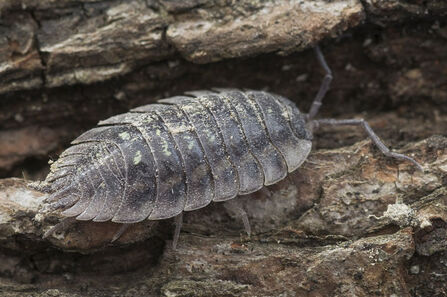
Common Woodlouse ©northeastwildlife.co.uk
One charismatic creature you may find during your leaf litter search is the common woodlouse. These hardy minibeasts can also be found sheltering under rocks and plant pots in the garden, and are important for their ability to feed off dead plants and creatures, recycling vital nutrients.
Woodlice are actually terrestrial crustaceans, not insects, so are more closely related to crabs and shrimps. There are 30 species of them in the UK in an array of colours from brown and grey to pink!
The small, Chinese muntjac deer was introduced to Woburn Park in Bedfordshire at the start of the 20th century and rapidly spread into the surrounding area. It is now a common animal across southeast England and can be found in woodland, parkland and even gardens.
Muntjac deer are notorious browsers, eating the shoots from shrubs, as well as woodland herbs and brambles. This clearing of woodland understory has been linked to declines in species such as nightingales.
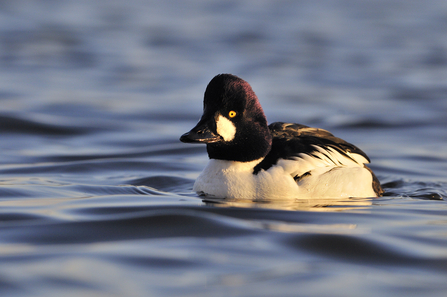
Male goldeneye by Fergus Gill/2020VIsion
Goldeneyes are distinctive ducks, often seen on large lakes and rivers. Keep an eye out for them at our Hosehill Lake and Calvert Jubilee nature reserves, where a few arrive most winters. Goldeneyes nest in the Scottish Highlands in cavities in trees so their chicks have to perform a great leap of faith the day after hatching to leave the nest and reach the ground! The population increases massively in winter due to migrants from the continent.
While blackcaps are typically summer visitors to our shores, these distinctive warblers have increasingly been seen around gardens in the UK from November to March. Recent tracking research has discovered that some of the blackcaps which breed in central Europe have changed their migration pattern, ditching the warm African and Mediterranean climate to brave the British winter!
This is due both to the increasingly warmer winters we experience as a result of climate change, and the abundance of garden bird feeders which provide a reliable source of food once all the fruits and berries have disappeared. See if you can spot them in a berry bush near you, and listen out for their melodic song.
Yew trees are frequently found in churchyards and at this time of year can be identified by their bright red 'berries' – properly called arils
Not all trees lose their leaves in the winter – but did you know we only have three native conifers in the UK? The Scots pine is mostly found north of the border; yews are frequently found in churchyards and at this time of year can be identified by their bright red 'berries' – properly called arils. Juniper is much scarcer than it used to be, but we have a healthy population at our Grangelands nature reserve in the Chilterns.